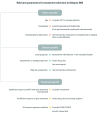Treatment of relapsed and refractory multiple myeloma
- PMID: 27033237
- PMCID: PMC5004403
- DOI: 10.3324/haematol.2015.129189
Treatment of relapsed and refractory multiple myeloma
Erratum in
-
Treatment of relapsed and refractory multiple myeloma.Haematologica. 2016 Aug;101(8):995. doi: 10.3324/haematol.2016.148882. Haematologica. 2016. PMID: 27478200 Free PMC article. No abstract available.
Abstract
The approach to the patient with relapsed or relapsed/refractory multiple myeloma (RRMM) requires a careful evaluation of the results of previous treatments, the toxicities associated with them and an assessment of prognostic factors. Since the majority of patients will have received prior therapy with drug combinations including a proteasome inhibitor and/or an immunomodulatory drug (IMiD), it is the physician's task to choose the right moment for the start of therapy and define with the patient which goals need to be achieved. The choice of regimen is usually based on prior responsiveness, drugs already received, prior adverse effects, the condition of the patient and expected effectiveness and tolerability. Many double and triple drug combinations are available. In addition, promising new drugs like pomalidomide, carfilzomib and monoclonal antibodies are, or will be, available shortly, while other options can be tried in clinical studies. Finally, supportive care and palliative options need to be considered in some patients. It is becoming increasingly more important to consider the therapeutic options for the whole duration of the disease rather than take a step by step approach, and to develop a systematic approach for each individual patient.
Copyright© Ferrata Storti Foundation.
Figures
References
-
- Palumbo A, Anderson K. Multiple myeloma. N Engl J Med. 2011;364(11):1046–1060. - PubMed
-
- Rajkumar SV, Dimopoulos MA, Palumbo A, et al. International Myeloma Working Group updated criteria for the diagnosis of multiple myeloma. Lancet Oncol. 2014;15(12):e538–e548. - PubMed
-
- Durie BG, Harousseau JL, Miguel JS, et al. International uniform response criteria for multiple myeloma. Leukemia. 2006;20(9): 1467–1473. - PubMed
Publication types
MeSH terms
Substances
LinkOut - more resources
Full Text Sources
Other Literature Sources
Medical



